Home » Representation » Seibu Giken DST
Seibu Giken DST Serbia
Seibu Giken DST is a global leader in the production of adsorption air dehumidifiers. From standalone units to large industrial solutions, designed to efficiently address moisture problems in numerous industrial applications.

Seibu Giken DST – Specialists in Dry Air
Seibu Giken DST is a specialized company in humidity control that provides complete solutions and dehumidifiers for a wide range of applications. Their broad range of devices, from standalone units to large industrial solutions, is designed to address moisture problems in industrial applications, preventing condensation, corrosion, as well as the growth of mold, mildew, and bacteria. The devices are characterized by high reliability, energy efficiency, and easy maintenance, enabling the efficient solution of problems caused by high humidity in the air.
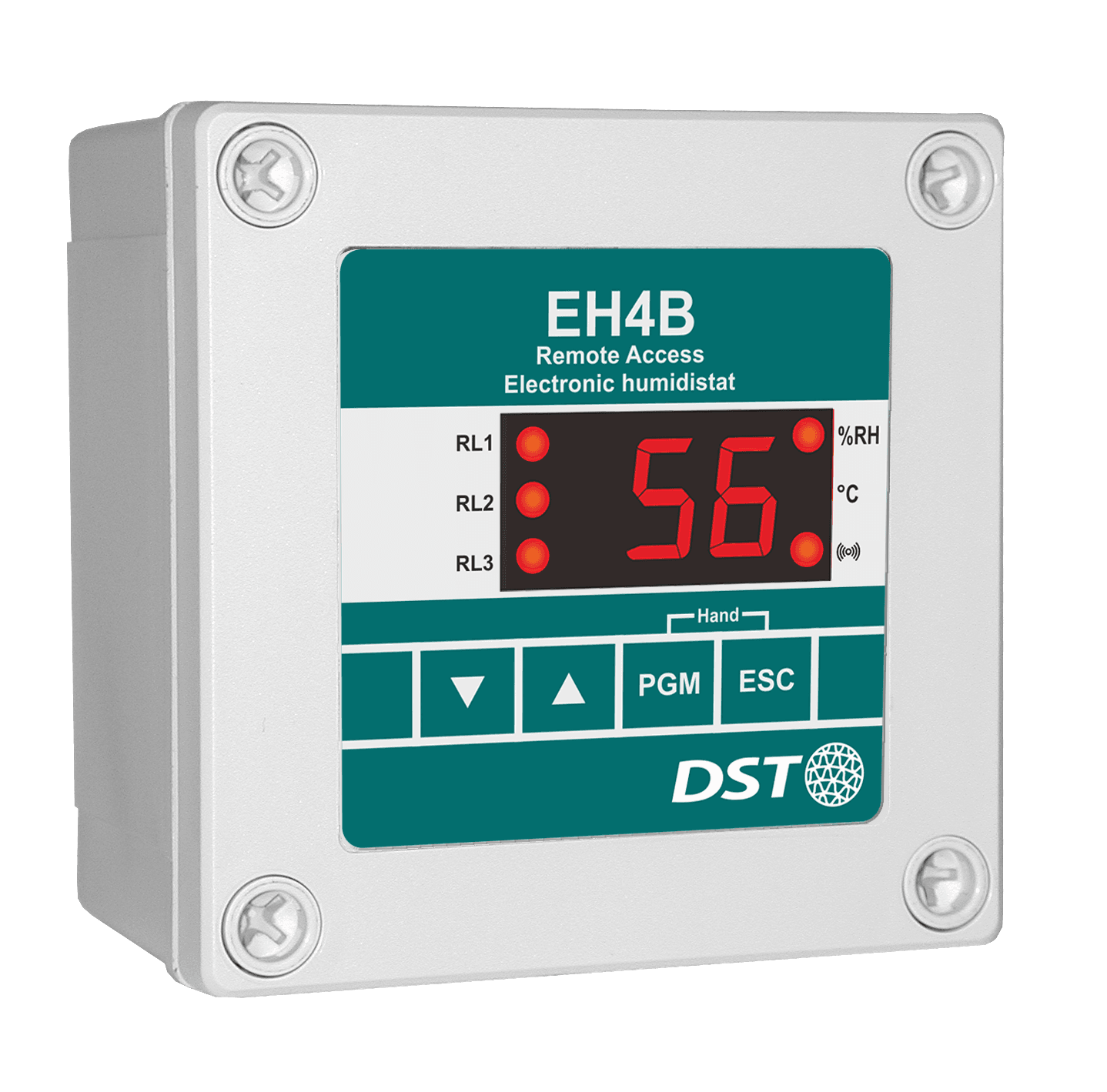
Meet Seibu Giken DST
Seibu Giken DST application in industry
Prevention of powder ingredient sticking, flow improvement, enhanced production process control, year-round humidity regulation regardless of external conditions, and full compliance with GMP standards.
Humidity control in cold storage prevents condensation and ice formation on evaporators, slippery floors, and protects products from damage. Controlled conditions maintain optimal storage parameters and ensure safety for personnel.
Prevention of sticking of hygroscopic materials, improved control of the ripening process, and inhibition of mold and fungus growth.
In lyophilized product processing and packaging areas, maintaining very low humidity is essential due to the product’s high hygroscopicity. Precise air drying prevents moisture reabsorption, improves quality, and extends the shelf life of the final product.
Ensures stable quality of chocolate and sugar, prevents condensation and sticking of dry ingredients.
Humidity control is crucial in glass lamination, as PVB film easily absorbs moisture, which can cause bubbles and poor adhesion between layers. Desiccant dehumidifiers ensure optimal humidity levels, preventing production defects and improving the quality of laminated glass.
Improved hygiene, reduced risk of contamination and slippery floors, faster drying after cleaning, fewer production interruptions, and a safer, more comfortable working environment.
High humidity issues arise in summer due to elevated moisture content in outdoor air, leading to condensation and equipment damage. Desiccant dehumidifiers enable precise dew point control to prevent condensation, avoiding corrosion, electrical failures, and paint peeling, while improving ambient conditions.
Preservation of valuable archival materials, safe storage of exhibits, and the ability to exhibit items in optimal humidity conditions year-round.
The use of desiccant dehumidifiers is critical in military facilities worldwide, protecting materials, key systems, and electronic equipment from corrosion, degradation, and failure. Their effectiveness enhances combat readiness, optimizes resource allocation, and reduces maintenance costs, ensuring long-term reliability and operational efficiency of military units.
Silica Gel Rotor – The Heart of DST Dehumidifiers
The heart of every DST dehumidifier is the D-Max rotor, manufactured by Seibu Giken Co. from Japan. As a world pioneer in the production of silica gel rotors, they remain the leader in rotor manufacturing technology.
The rotor is the most important component of the device, determining its capacity, efficiency, and durability. The silica gel is permanently bonded to the supporting structure of the rotor by chemical and thermal treatment, which prevents the separation of desiccant particles into the process air. After ten years of operation, with proper maintenance, the Seibu Giken D-Max rotor retains at least 90% of its nominal capacity, ensuring stable performance and reliable humidity control.
The only rotor on the market that can be washed and have its capacity restored after dust contamination.
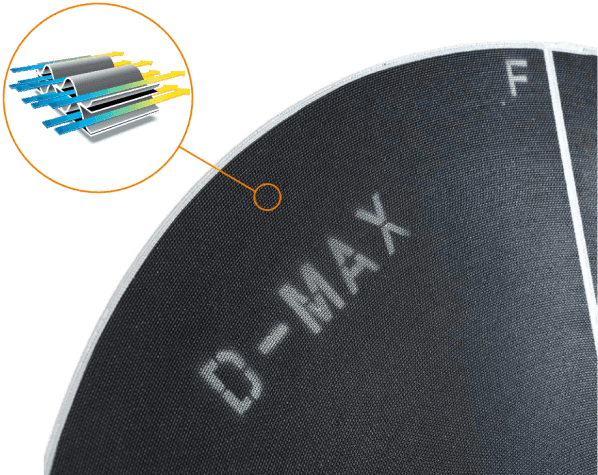
Operating principle
In adsorption dehumidification, the rotor inside the device continuously adsorbs (attracts) moisture from the process air, then during the regeneration cycle it desorbs and releases it into the external environment as exhaust air.
The Consorb principle is used when regeneration temperatures are low, for example when waste heat is available or when moisture in the process air is extremely high. These units are ideal for closed systems where dry air is recirculated.
Recusorb R units have an internal heat recovery system to increase efficiency. During the regeneration phase, the heat emitted by the rotor is recovered by the incoming regenerative air, reducing the energy consumption for heating. The exhaust air in this process has lower temperature and humidity compared to other systems.
Additionally, there are other derived operating principles available in the brochure.
Moisture problems solved by drying
Condensation
No condensation will occur on surfaces if the air in contact with them has a dew point lower than the surface temperature. Examples: walls, panel walls, pipelines with cold fluid.
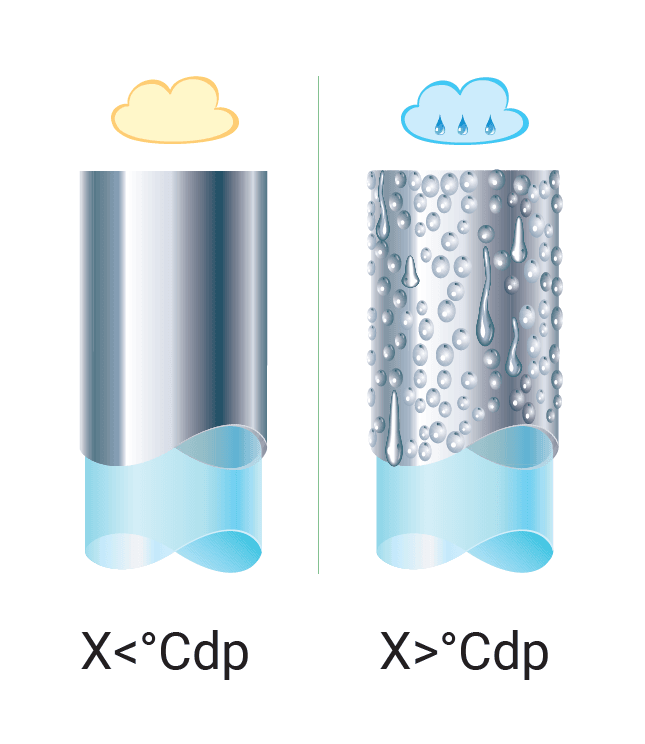
Mold and fungi
Growth of mold and fungi is prevented if the relative humidity in the space is maintained below 70% RH.
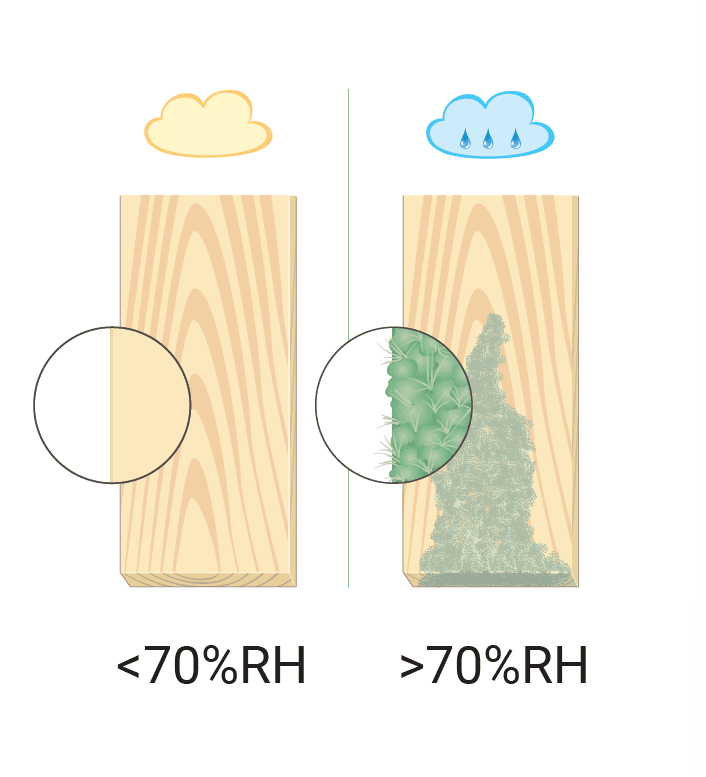
Corrosion
Corrosion is eliminated if the air in contact with the surface is kept below 50% RH.
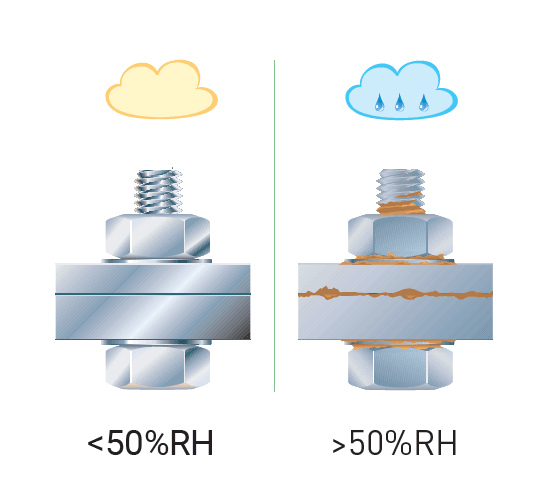
Bacteria
If relative humidity is maintained below 50%, bacteria cannot multiply.
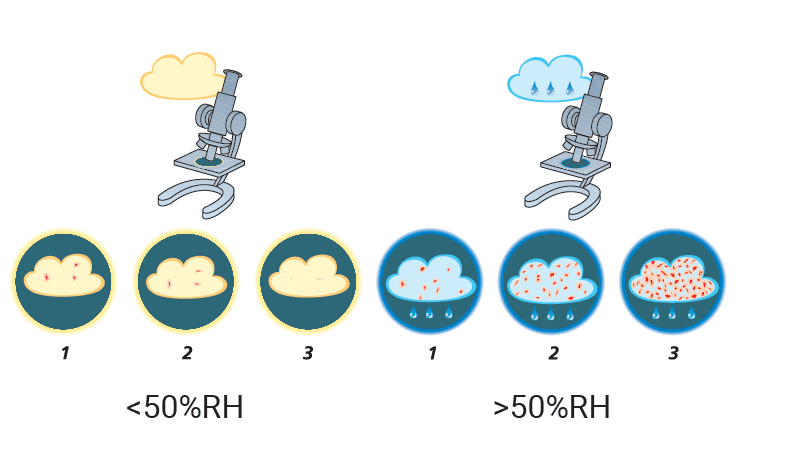
Hygroscopic materials
The quality of dry medicines, dry food, hard candies, and other hygroscopic materials can only be preserved from production to consumer if they are exposed to air with low relative humidity. Most hygroscopic materials are stable below 50% RH, while some, like instant drink powders, require humidity below 15% RH.
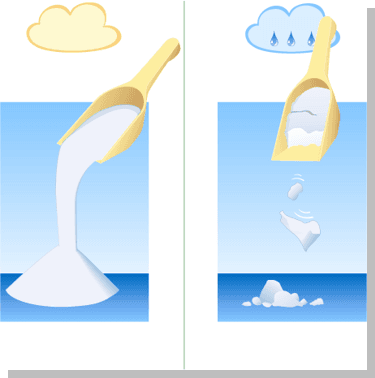
Ice formation
On cold surfaces in cold storage, loading ramps, and evaporators, freezing will not occur if the surrounding air has a dew point lower than the surface temperature.
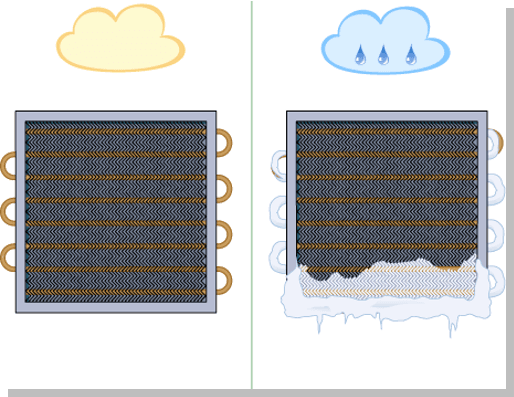
Electronic components
Prolonged exposure to moisture can cause oxidation of metal parts, weakening connections and reducing conductivity. Condensation on components also increases the risk of short circuits.
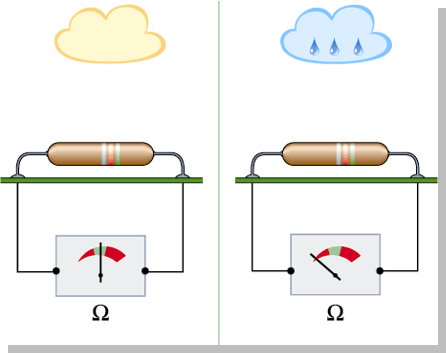
Product drying
During product drying, low humidity is key for a fast and efficient process. If products are sensitive to high temperatures, the required low humidity can only be achieved by dehumidification, not by heating.

DC and DR – small series
The range of smaller industrial dehumidifiers is used for drying spaces after floods, as well as in museums, antique shops, laboratories, warehouses, silos, and smaller production processes.
All small units are made of stainless steel as standard and are available in three configurations: Aquasorb (AQ30), Consorb (DC), and Recusorb (DR).
RL Series Mid-Range Units
Mid-range industrial dehumidifiers are suitable for warehouses, cold storage, sports halls, museums, clean rooms, pneumatic conveying, and process air conditioning.
Made of stainless steel, these units feature internal heat recovery (Recusorb), electric reactivation, and Auto/Manual operating modes.
Pre-wired for two-stage binary control (with EH4 2-step controller) as standard. The units can also operate with linear capacity control (using an EH3-T PI controller or a BMS control signal).
The devices come equipped with a high-capacity D-Max Seibu Giken silica gel rotor, G4 or F7 panel filters, reactivation heater, process and reactivation fans, and other necessary controls. A steam reactivation version is also available.
RLZ and CZ Series – Large Units
Large industrial dehumidifiers are ideal for warehouses, cold storage, sports halls, museums, clean rooms, pneumatic conveying, and process air conditioning. Manufactured with an Aluzinc alloy finish, Recusorb RLZ units come as standard with internal heat recovery. Units are available with electric, steam, gas, or hot water reactivation heaters. Standard features include two-stage binary control (EH4 2-step controller) with the option for linear capacity regulation (EH3-T PI controller or BMS signal).
The devices use a high-capacity D-Max Seibu Giken silica gel rotor, G4 or F7 panel filters, reactivation heater, and fans for both process and reactivation air, along with all necessary controls.
The Consorb CZ series is especially suited for moisture control applications requiring low regeneration temperatures, where waste heat is available, or where process air humidity is extremely high.
All RLZ & CZ dehumidifiers come as standard with G4 filters, process and reactivation fans, reactivation heater, D-Max Seibu Giken drying rotor, electric control panel, and PLC C2 with full capacity control system integration.
Flexisorb (RF & CF) – Special Large Units for Industrial Applications
Flexisorb units are tailored to the individual needs of industrial processes, especially in the process industry. These flexible dehumidification systems can be configured from a basic rotor unit up to a complete system with a climate control module, offering a high degree of adaptability.
These highly efficient industrial units are built around the rotor as the central component, ensuring reliable dehumidification and meeting specific user requirements. The configuration can be either Recusorb or Consorb, depending on the application.
The primary function of the Flexisorb system is dehumidification, but it also allows integration of precoolers, aftercoolers, and reheaters, making it one of the most versatile solutions on the market. These units can achieve dew points as low as -60°C in a single pass, providing optimal moisture control in the most demanding industrial applications.
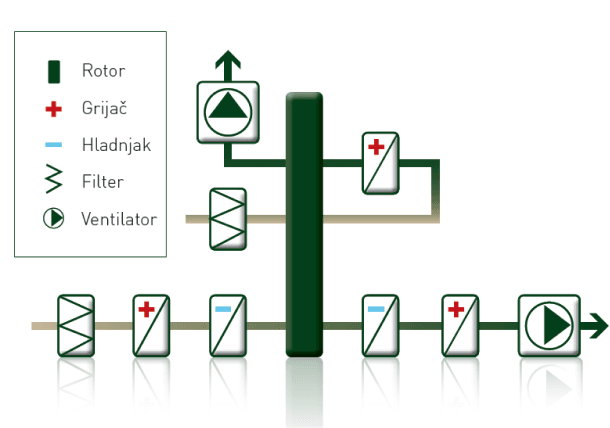
Advantages of the Flexisorb System
All Flexisorb dehumidifiers are designed to be energy-efficient and environmentally friendly. Regenerative heaters can run on natural gas, LPG, steam, hot water, electric power — or any combination of two. Flexisorb units are constructed from anodized aluminum profiles and feature smooth internal surfaces, which facilitate easy cleaning. Stainless steel panels are also optionally available for dryers operating in aggressive environments, and similar conditions.
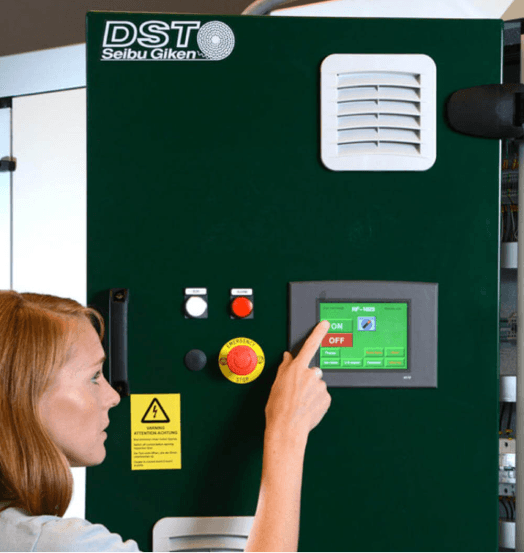
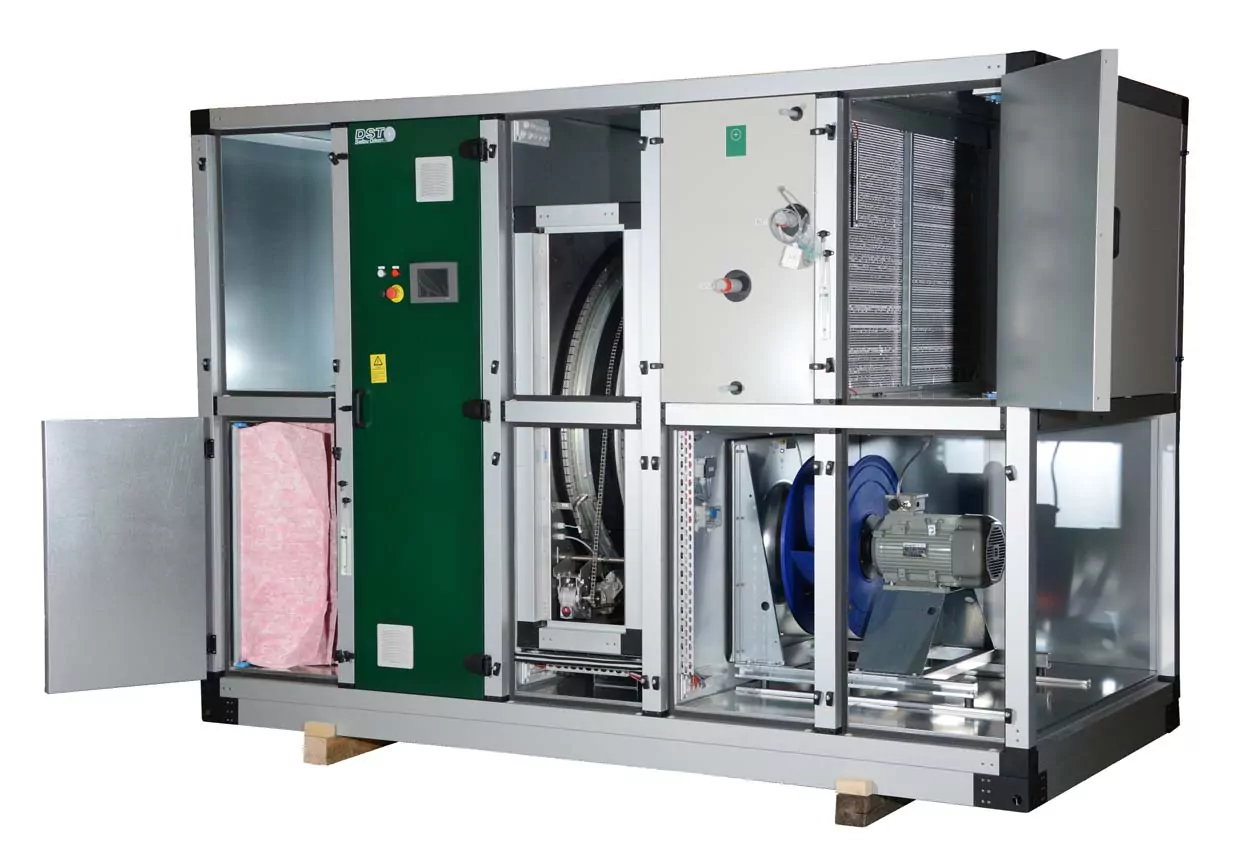
Dehumidification in Lithium Battery Manufacturing
Lithium batteries are a source of energy currently regarded as the savior of the modern technological world. Today, the demand for lithium-ion batteries is rapidly increasing as the automotive industry transitions from internal combustion engines to electric vehicles. DST provides climate control solutions for lithium battery production. DST adsorption dehumidifiers enable extremely low relative humidity levels below 1% RH.
If humidity is elevated in the production area, lithium can react with moisture and transform into lithium hydroxide and highly flammable hydrogen, significantly deteriorating product quality performance and durability.
Energy-Efficient Control for DST Industrial Dehumidifiers
As energy efficiency standards tighten and energy costs rise, DST applies advanced control technologies to ensure optimal savings and sustainability. Our products are designed to consume less energy and reduce operational costs while helping to preserve the environment.
The PLC controllers offered by DST aim to improve operational efficiency, reduce carbon dioxide emissions, and optimize operating expenses, making them essential for achieving environmental certifications. The C2, C4, and C7 models are tailored to specific projects to ensure maximum energy savings and reliability. They can be used standalone, alongside digital controllers EH3 and EH4, or integrated into a BMS system for precise regulation and easy monitoring.
Main functions of the PLC controllers:
- Intuitive and user-friendly interface
- Synchronization of key component operation
- Monitoring of protective systems, interruptions, and alarms
- Unit capacity adjustment to maintain optimal humidity, airflow, and temperature
PLC Type C2 for Industrial Dehumidifiers (RLZ, CZ, RF)
The basic DST PLC type C2 comes as a standard option for all our industrial dehumidifiers. The intuitive keypad allows easy menu access, while the dual-line backlit LCD displays important information to the user. When used together with one of our controllers (EH3 & EH4) or an external control system (BMS), the drying capacity of the dehumidifier can be precisely adjusted to maintain the desired humidity level exactly.
PLC Type C2 specifications:
- Digital inputs: 9
- Digital outputs: 7
- Analog inputs: 4
- Analog outputs: 2
PLC Type C4: Humidity, Temperature, and Airflow Control – Remote and Local
The PLC type C4 enables multifunctional control of the entire drying system and related processes. Customized software ensures efficient operation management and optimal energy efficiency.
The intuitive color LCD screen with graphical component displays and real-time operational data makes monitoring and adjustments easy. The user interface offers simple menu access, and the 5.7-inch backlit display clearly shows important messages to the user.
PLC type C4 allows easy expansion of functionality, so additional options can be added without difficulty. Using a free PC software tool, the PLC operation can be remotely monitored and adjusted via the internet.
PLC Type C4 specifications:
- Digital inputs: 16
- Digital outputs: 16
- Analog inputs: 4
- Analog outputs: 4
Type EH3-T2: Humidistat and Controller
EH3-T2 is a PI controller designed for precise control of humidity and temperature levels. It allows regulation of:
- Relative Humidity (% RH)
- Absolute Humidity (g/kg)
- Dew Point (°Cdp)
- Temperature (°C / K / °F)
Main features:
- Two independent PI controllers
- Optional temperature sensor for floating dew point to prevent condensation
- Duct temperature sensor can be used for air temperature control
- Communication via Modbus RTU for integration into broader control systems
- Additional displays available as needed
Additional option:
Condensation Prevention – A second temperature sensor is installed on the cold surface where condensation should be prevented and serves as a reference for the controller to regulate the dew point of dry air according to a special program (Floating dew point).
Type EH4: Humidistat
Three-stage humidistat with a fast digital sensor.
- Fast response digital sensor for precise humidity control.
- Three independent potential-free relays for flexible management.
- Visible “High RH” alarm warning of excessive humidity.
- Temperature indication and control for optimized conditions.
- Can also be used for humidification.
Three switching contacts: Flexible control
- Three independently programmable relays with adjustable hysteresis, enabling precise control of dehumidification and humidification.
- Multi-level control – Can be used for two-stage dehumidifier control plus one alarm function, or a combination of dehumidification, humidification, and temperature control.
Display and indicators
- High-visibility display (RH and °C, 15 mm) for clear overview of settings.
- Neon indicator lights show relay status.
- Display flashes if the set “High RH” value is exceeded or if the sensor is disconnected.
Sensor
- Fast-responding humidity and temperature sensors can be mounted on a wall or in a duct.
- Factory calibrated, with accuracy better than ±2% RH and ±0.5°C.
Additional options
- Bluetooth communication (range up to 30m).
- Remote control via free mobile app for iOS and Android.

Frequently Asked Questions about Seibu Giken DST
What are the main advantages of adsorption dehumidifiers in industry?
They provide stable performance at low temperatures, consume less energy, and effectively control moisture in demanding industrial environments. These units are reliable, compact, and adaptable to various industrial applications.
Does the silica gel wear out and need to be replenished?
No, it is not necessary to replenish the silica gel in the rotors of adsorption dehumidifiers because the material is permanently integrated into the structure. The rotor continuously regenerates during operation with warm air, ensuring long-lasting efficiency without the need for replacement or replenishment.
How to properly choose the right dehumidifier model?
The selection depends on the size of the space and the moisture inflow, the humidity level that needs to be maintained, the temperature, and specific industry requirements. For each application a special calculation is made to select the appropriate dehumidifier.
Do you offer service support?
Yes, as the exclusive representative of Seibu Giken DST equipment in Serbia, we provide complete service and after-sales support for these devices, including the supply of spare parts.
How to maintain and service adsorption dehumidifiers for maximum lifetime and reliability?
At least once a year, get a service inspection done by our authorized service team, including performance measurements. Regular filter replacement and servicing ensure optimal operation and extend the device’s lifespan.
